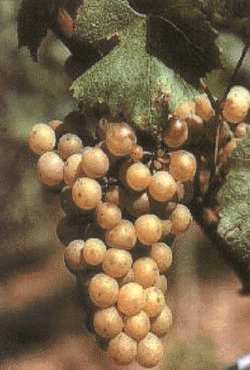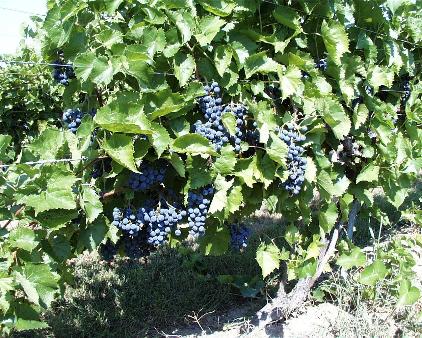See Also: Michigan grapes
Native Grapes
The first grapes grown commercially in Michigan were juice
grapes. These were varieties that were native to North America (Vitis Labrusca)
and as such were well adapted to the climate and plant diseases present in Michigan.
For example, they can withstand cold temperatures and are resistant to the pathogen Phylloxera,
a disease carried by aphids that feed on American vines and which destroyed the French
wine industry in the late 1800s (learn more).
Among these grape varieties are Concord (Red) and Niagara (White).
Ephraim Bull of Massachusetts was one of the first to commercially cultivate native grapes
in 1806. Unfortunately these grapes have a rather foxy taste when made into wine and
so they are largely used for juice and for table grapes. Welch's is a major buyer
of Michigan juice grapes.
Wine Grapes
 Chardonnay Grapes |
 Riesling Grapes |
|
Source: Unknown | |
The fine (and expensive) wines of the world are made primarily out of the European grape (Vitis Vinifera). This is the grape species that has been cultivated for wine in Europe for thousands of years. The vinifera grape evolved in Eastern Europe and Southwestern Asia and numerous varieties have been cultivated to compensate for variations in climate across Europe. In warm regions with late summers (such as Bordeaux, Italy and Spain), it is possible to grow the late harvest red wine grapes like Pinot Noir, Merlot, and Cabernet Sauvignon. As one moves to cooler climates (Northern France, Austria, Germany), earlier, white varieties dominate (Chardonnay, Riesling, Gew�rztraminer). Because Michigan has a climate similar to more northerly areas of Europe, it is common sense that the early maturing, white varieties could be grown here with good results. Indeed, that has been the case, and among the European varieties, Riesling and Chardonnay dominate in Michigan. Acreage of vinifera varieties is increasing in Michigan as growers realize the large profits that can be made growing high quality wine grapes. However, Vinifera is much more sensitive to cold weather than Labrusca, and also is not resistant to Phylloxera. This is why much of the European wine industry was wiped out in the late-1800s by a phylloxera outbreak started by the importation of Labrusca vines into Europe. Hybrid varieties
 Mar�chal Foch |
 Chancellor |
Source: Photos courtesy of Karsten Shien
By far the most common wine grapes grown in Michigan are European-American hybrids. These are varieties that have been developed by grafting European Vinifera vines to American Labrusca root stocks. This grafting gives hybrid varieties many good characteristics of both. From the Vinifera comes the desireable taste, and from the Labrusca comes the cold hardiness and disease resistance needed in many parts of the US (and the world). There are literally thousands of hybrid varieties, but some of the more common ones grown in Michigan are Chancellor and Mar�chal Foch (both reds), and Seyval Blanc and Vignoles (white). Michigan State University Horticulture Department professors Howell and Zabadal, and the MSU Agricultural Extension Service do a lot of research on growing these grapes and making wine from them.
Next: Commercial Wineries (3 of 3)
This material has been compiled for educational use only, and may not be reproduced without permission. One copy may be printed for personal use. Please contact Randall Schaetzl (soils@msu.edu) for more information or permissions.